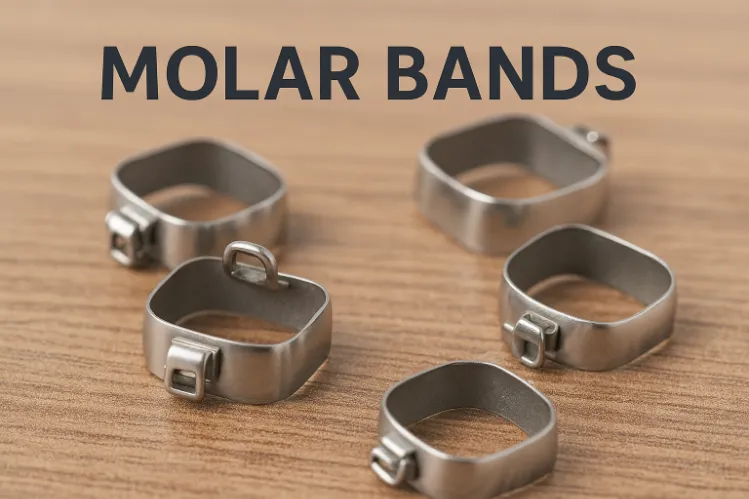
Retainers serve a more significant purpose than simply being accessories to your dental care regimen. They are a vital part in maintaining your perfect smile after you have gone through clear aligners or braces. However, what should you do when your trusted retainer is no longer a good fit? You may be wondering what to do if your retainer doesn't fit anymore. This is something many people run into after finishing treatment, regardless of whether you finished orthodontic treatment a few months or a few years ago.
In this blog, we will help you understand how to tell if your retainer does not fit, when it becomes a problem if your retainer is too tight and may damage your teeth, and finally, how you can get a new retainer. Regardless of whether your retainer is plastic or wire, we are here to help you clear up the issue and protect your precious smile!
After investing time and money in straightening your teeth, retainers play a crucial role in keeping them aligned. Teeth naturally tend to move back to their original positions, a process known as "orthodontic relapse." Retainers are essential to prevent this shift.
The fit of your retainer is important; if it's too loose, it won't hold your teeth in place, and if it's too tight, it can cause damage. Regularly monitoring the fit is vital. Self-checks and periodic visits to your orthodontist can help ensure your retainer is effective, protecting your investment and preserving your smile.

It’s not always obvious at first. A slight change in comfort might seem minor, but here are some signs that your retainer is no longer fitting properly:
It is normal to have a tight retainer, especially if you have not worn it for days or more. But if it feels like your teeth are being forced to move or is painful for longer than 15-30 minutes, then something is wrong. A tight retainer can damage teeth by putting unnatural pressure on them, resulting in discomfort, gum recession, or, if forced on it, could misalign them. So, do not try to power through the pain and make things worse.
One of the most noticeable signs that your teeth may have shifted is when you find it challenging to fit your retainer comfortably. If you try to place the retainer in your mouth and experience discomfort, pain, or if you notice gaps between the retainer and your teeth, your teeth have likely moved from their original position.
This can occur due to a variety of factors, such as not wearing the retainer as recommended, changes in your bite, or natural shifts that happen over time. In this case, a visit to your orthodontist becomes important to assess the situation and determine the best course of action to avoid further misalignment.
Sometimes, the issue is subtle. Your teeth may not look different, but your bite might feel misaligned or “off.” This could be the result of a slight shift, and your retainer might not be holding your teeth in place anymore.
Plastic retainers, such as Essix retainers, are designed to hold teeth in their new positions after orthodontic treatment. However, if you start to notice a clicking sound when you wear them or if they pop off unexpectedly, this can indicate a problem.
This suggests that your retainer no longer fits your dental arch correctly. It's essential to address this promptly, as an ill-fitting retainer can compromise your orthodontic results.
Loose retainers are ineffective. If you can move your retainer with your tongue, or it doesn’t stay in place securely, it’s no longer doing its job.
Let’s break it down in detail:
This is the most common reason for tooth shifting after orthodontic treatment. If you’ve stopped wearing your retainer consistently, even for a short period, your teeth may begin to move back to their original positions. Maintaining the habit of wearing your retainer as prescribed—typically every night- ensures that your teeth remain in the desired alignment. Consistency is key, and even a few days of not wearing it can lead to noticeable changes.
Various factors can affect how well your retainer fits over time. For instance, the emergence of wisdom teeth can exert pressure on your existing teeth, causing them to shift. Additionally, as you age, your jawbone and bite can change, which might alter the alignment and comfort of your retainer. If you notice discomfort or that your retainer no longer fits properly, it could be time to consult with your orthodontist.
Taking care of your retainer is essential to its longevity and effectiveness. Using hot water to clean it can warp the material, while not cleaning it thoroughly can lead to bacteria buildup, bad odors, and potential dental issues. It’s advisable to follow your orthodontist’s guidelines for cleaning and storing your retainer to ensure it remains in good shape. Regular cleaning with mild soap and lukewarm water is often recommended.
By understanding these factors, you can take proactive steps to maintain your oral health and ensure that your smile stays as straight as possible.
If the fit issue is mild, you might be able to fix it yourself, but only under certain conditions. Here are some safe things you can try:
Important: These tips work only if your teeth have shifted very slightly. If your retainer is visibly warped, cracked, or too painful to wear, stop trying to fix it at home and consult a professional.
Can a Tight Retainer Damage Teeth?
Absolutely, and it’s more common than you might think.
While some tightness is expected when reintroducing a retainer, prolonged or intense pressure can lead to:
If your tight retainer is causing headaches, soreness in your jaw, or aching gums, discontinue use and see your orthodontist.
If your old retainer just isn't going to cut it anymore, don't fret. Replacing it is simple!
Your orthodontist will assess your teeth to see how far they've shifted to determine if you need some minor adjustments to your teeth or if you need to produce a whole new mold from start to finish.
Three types of retainers are commonly used.
Your orthodontist will make a mold or take a 3D scan of your mouth so that they can then make your new retainer.
When you finally receive your new retainer, make sure to follow your orthodontist's instructions very closely, as wearing it properly is the most important part!
When your retainer is no longer fitting properly, it is important to find a reliable, comfortable replacement that fits you well. Here are some reputable brands, each one has high-quality retainers and satisfied customers:

Caspersmile is one of the fastest-growing aligner brands. They offer a retention plan for a one-time payment of £499. This comprehensive package includes eight sets of custom-made, BPA-free retainers, ensuring durability and a perfect fit. The plan also provides a free impression kit, a retainer case, and a personalized video session to guide you through the process. With free shipping and a perfect fit guarantee, Caspersmile makes it convenient and affordable to maintain your beautifully aligned teeth.

Maintain your perfect smile effortlessly with NewSmile Retainers, designed for a convenient and affordable way to keep your teeth aligned. For just £129, you'll receive a custom-fit retainer crafted from high-quality, FDA-approved materials, along with a free impression kit and shipping. To ensure optimal results, it's recommended to replace your retainer every six months.

Diamond Whites Retainers are a perfect finishing touch for your teeth-straightening journey . They offer high-quality aligners and retainers, starting from just £200. The recommended wear time for them is full-time for one week, followed by nighttime use.
How Long Can You Go without Wearing a Retainer? (H2)
Not long. Teeth can start to shift within a few days of stopping retainer use, especially in the months following orthodontic treatment.
If it’s been:

Your retainer is a great asset if it fits; if not, it’s useless. Don’t ignore the signs if you notice your teeth have moved or the plastic feels uncomfortable, or your retainer simply does not fit. If you address this issue promptly, you can avoid any prolonged dental challenge and preserve your spectacular, straight smile.
If you think your retainer does not fit, schedule your consultation today. The sooner you address the issue, the more likely you are to avoid extensive re-treatment.




Curated the best for your knowledge
.png) Metallic Taste in Mouth: Causes and How to Get Rid of It
Metallic Taste in Mouth: Causes and How to Get Rid of ItHaving metal taste in the mouth first thing in the morning can be an unexpected experience. You wake up, take a swallow, and suddenly have a metallic taste in your mouth, as if you'd been chewing on a handful of change. It's annoying, a little scary, and sometimes for no apparent reason. For some people, it will be nothing but a minor nuisance; others may fall into the late-night goose chaser. Sometimes it's a sign that there is something wrong with your braces; other times, it could mean that there is something wrong with one of your teeth. But here's the good news: Most metallic tastes are temporary, harmless, and can be treated or resolved. So let's take a closer look at the possibilities.
Read More How Molar Bands Work in Braces and Retainers to Keep Your Teeth in Line
How Molar Bands Work in Braces and Retainers to Keep Your Teeth in LineIf you’ve ever started orthodontic treatment, you already know there are a lot of tiny pieces involved. Wires, brackets, elastics, retainers, attachments… and then there are molar bands. They’re not as famous as braces themselves, but they play a surprisingly big role in keeping your smile moving in the right direction. Some people don’t really notice them. While others desperately want to know why that metal ring is even there. So let’s break it all down: what molar bands are, why orthodontists use them, and how they work in both braces and retainers. Plus, what you should expect throughout the process.
Read More.webp) Dental Bonding Cost: Prices, Process & What to Know
Dental Bonding Cost: Prices, Process & What to KnowIf you’re thinking about fixing a chipped tooth, closing a gap, or smoothing out uneven edges, dental bonding is often the easiest (and quickest) way to do it. And honestly? It’s one of the most budget-friendly cosmetic treatments out there, if you know what to expect. But here’s the part everyone worries about first: “How much does tooth bonding cost?” The short answer: it depends. The long answer: let’s break it all down so you actually understand where the price comes from, what you’re paying for, and whether bonding is the right fix for your smile.
Read MoreQuick Links

Heading